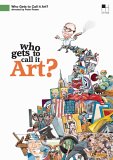| Reviews & Columns |
|
Reviews DVD TV on DVD Blu-ray 4K UHD International DVDs In Theaters Reviews by Studio Video Games Features Collector Series DVDs Easter Egg Database Interviews DVD Talk Radio Feature Articles Columns Anime Talk DVD Savant Horror DVDs The M.O.D. Squad Art House HD Talk Silent DVD
|
DVD Talk Forum |
|
|
| Resources |
|
DVD Price Search Customer Service #'s RCE Info Links |
|
Columns
|
|
|
Who Gets to Call It Art?
Legendary curator Henry Geldzahler (1935-1994) is supposed to be at the center of it all, though as the subject of this documentary one doesn't learn all that much about him, other than he was open-minded about new art forms and attracted to contemporary American art at a time when the entire movement - a postwar "silent minority" of artists and audience is how one artist describes it - seemed to be limited to a few hundred people working out of lofts in Lower Manhattan.
Porky Pig with a big cigar, Geldzahler was confidently opinionated and not at all hesitant to be controversial. Artists generally liked him because he was the one curator who "lived with the artists." He seems to have posed for just about every major artist of the period, and also appears in several of Andy Warhol's films, and as a performer in footage from various "happenings." He loved being in the spotlight, but genuinely loved art, and was a major force in promoting several generations of postwar American artists.
His landmark, highly controversial retrospective of contemporary art dating back to 1940 and including some of the most significant examples of abstract expressionism, pop art and the like, was held in 1970 at the Metropolitan Museum of Art, a real dinosaur of a place before he moved in, and this becomes the film's high point. An equally landmark auction of contemporary art two years later symbolized the end of the movement, signaling a money-obsessed trend many of these artists and Geldzahler found distasteful.
The documentary works best when it slows down long enough to allow viewers to get a sense of the kind person Geldzahler was. Ironically, for all its razzle-dazzle, some of the film's best scenes are its simplest: several times Geldzahler, in some sort of audio-taped lecture, talks about various works while onscreen we see the painting or the sculpture, and maybe shots of the artists creating that very work. That's a lot more interesting than all that fast cutting.
Video & Audio
The DVD of Who Gets to Call It Art? is a let-down as it's presented in a 4:3, unenhanced letterboxed transfer at about 1.70:1. The image is otherwise fine, but why not enhance it? This is, after all, a DVD about art: shouldn't it be as sharp and as accurately reproduced as technologically possible? There are also no subtitle or alternate audio options.
Extra Features
Supplements include Additional Artist Interviews, roughly 14 minutes worth of cutting room floor snippets featuring several artists appearing in new interview footage: Frank Stella, James Rosenquist, John Chamberlain, David Hockney, Larry Poons, and Mark di Suvero. An audio-only Q&A with James Rosenquist, Larry Poons, and Director Peter Rosen follows. It's derived from the film's February 2006 premiere at the Film Forum in New York.
Also included is Fotodeath (1961), a "Claes Oldenburg Happening" shot silent in black & white 16mm. It runs 14 minutes. Finally, a Theatrical Trailer pretty much sums up the movies problems and qualities.
Parting Thoughts
In National Lampoon's European Vacation, there's a great line as the Griswold Family is visiting Paris: "C'mon kids," Dad says, "The Louvre is closing in 15 minutes and we've got 150,000 works of art to see!" One gets that same feeling rushing though Who Gets to Call It Art?.
Stuart Galbraith IV is a Kyoto-based film historian whose work includes The Emperor and the Wolf - The Lives and Films of Akira Kurosawa and Toshiro Mifune and Taschen's forthcoming Cinema Nippon. Visit Stuart's Cine Blogarama here.
|
| Popular Reviews |
| Sponsored Links |
|
|
| Sponsored Links |
|
|
| Release List | Reviews | Shop | Newsletter | Forum | DVD Giveaways | Blu-Ray | Advertise |
|
Copyright 2024 DVDTalk.com All Rights Reserved. Legal Info, Privacy Policy, Terms of Use,
Manage Preferences,
Your Privacy Choices | |||||||













